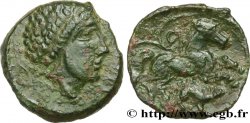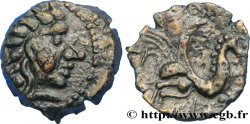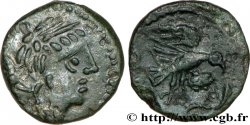v34_1266 - GALLIA - CARNUTES (Beauce area) Quart de statère d’or au loup conducteur
MONNAIES 34 (2008)
Starting price : 480.00 €
Estimate : 700.00 €
Realised price : 635.00 €
Number of bids : 2
Maximum bid : 750.00 €
Starting price : 480.00 €
Estimate : 700.00 €
Realised price : 635.00 €
Number of bids : 2
Maximum bid : 750.00 €
Type : Quart de statère d’or au loup conducteur
Date: Ier siècle avant J.-C.
Mint name / Town : Chartres (28)
Metal : gold
Diameter : 12,5 mm
Orientation dies : 5 h.
Weight : 1,99 g.
Rarity : R2
Coments on the condition:
Belle monnaie pour ce type plutôt rare, en très bon or. Le droit est mal frappé, avec une impression de coin rouillé. Le revers est complet et bien centré sur un flan relativement large
Obverse
Obverse legend : ANÉPIGRAPHE.
Obverse description : Tête imitée de Philippe II, à droite ; la base du cou perlée.
Reverse
Reverse legend : ANÉPIGRAPHE.
Reverse description : Cheval harnaché à droite, loup-aurige sur la croupe ; petit aigle aux ailes éployées entre les jambes du cheval ; une ligne ondulée devant le cheval.
Commentary
Dans le Nouvel Atlas, cette monnaie est reprise sous la série "au loup conducteur". Si aucun statère n’est connu, un hémi-statère va prochainement être publiés (un second exemplaire est connu, mais fourré, frappé avec les même coins).








 Report a mistake
Report a mistake Print the page
Print the page Share my selection
Share my selection Ask a question
Ask a question Consign / sell
Consign / sell
 Full data
Full data



